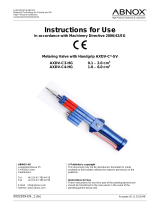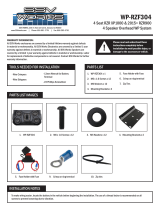- 3 -
951-171-049
Version 02
EN
Table of contents
Table of contents
Legal notice .................................................................................................2
Explanation of symbols, signs and abbreviations ........................................6
1. Safety instructions .........................................................................8
1.1 General safety instructions .................................................................... 8
1.2 General behaviour when handling the product ...................................8
1.3 Intended use ............................................................................................9
1.4 Foreseeable misuse ................................................................................ 9
1.5 Reference on Pressure Equipment Directive 2014/68/EU ..............10
1.6 Modifications of the product ................................................................10
1.7 Inspections prior to delivery ................................................................10
1.8 Other applicable documents ................................................................10
1.9 Persons authorized to operate the pump ..........................................11
1.9.1 Operator ................................................................................................. 11
1.9.2 Specialist in mechanics ........................................................................11
1.9.3 Specialist in electrics ............................................................................11
1.10 Briefing of external technicians...........................................................11
1.11 Provision of personal protective equipment ......................................11
1.12 Operation ...............................................................................................11
1.13 Emergency stopping .............................................................................11
1.14 Transport, installation, maintenance, malfunctions,
repair, shutdown, disposal ...................................................................12
1.15 Initial commissioning / daily start-up .................................................13
1.16 Cleaning .................................................................................................13
1.17 Markings and conventions ...................................................................14
1.18 Residual risks ........................................................................................15
2. Lubricants ................................................................................... 16
2.1 General information .............................................................................16
2.2 Selection of lubricants .......................................................................... 17
2.3 Material compatibility ...........................................................................17
2.4 Temperature characteristics ................................................................17
2.5 Ageing of lubricants ..............................................................................17
2.6 Solid lubricants in lubrication greases ................................................18
2.6.1 Chisel pastes ..........................................................................................18
3. Overview, functional description ................................................ 19
3.1 General information .............................................................................19
3.2 Fields of application ..............................................................................20
3.3 Function monitoring options ...............................................................21
3.3.1 Visual monitoring with indicator pin ................................................... 21
3.3.2 Electrical monitoring/controlling via proximity switch ......................21
3.3.3 Electrical monitoring/controlling via piston detector ........................21
3.3.4 System-related monitoring ................................................................. 21
3.4 Course of the lubricant in the SSV metering device ..........................23
3.5 Course of the lubricant in the SSVD metering device .......................28
4. Technical data ............................................................................. 35
4.1 Technical data SSV/SSV-E/SSVM .......................................................35
4.1.1 Construction sizes, dimensions and weights SSV/SSV-E/SSVM ....36
4.1.2 Tightening torques SSV/SSV-E ...........................................................37
4.1.3 Tightening torques SSVM ....................................................................38
4.2 Technical data SSVD/SSVD-E .............................................................39
4.2.1 Construction sizes, dimensions and weights SSVD/SSVD-E ...........40
4.2.2 Tightening torques SSVD/SSVD-E .....................................................41
4.3 Technical data of the SSVL/SSVDL .....................................................42
4.3.1 SSVL/SSVDL .........................................................................................43
4.4 Tightening torques SSVL, SSVDL .......................................................44
4.5 Technical data of the universal piston detector .................................45

























